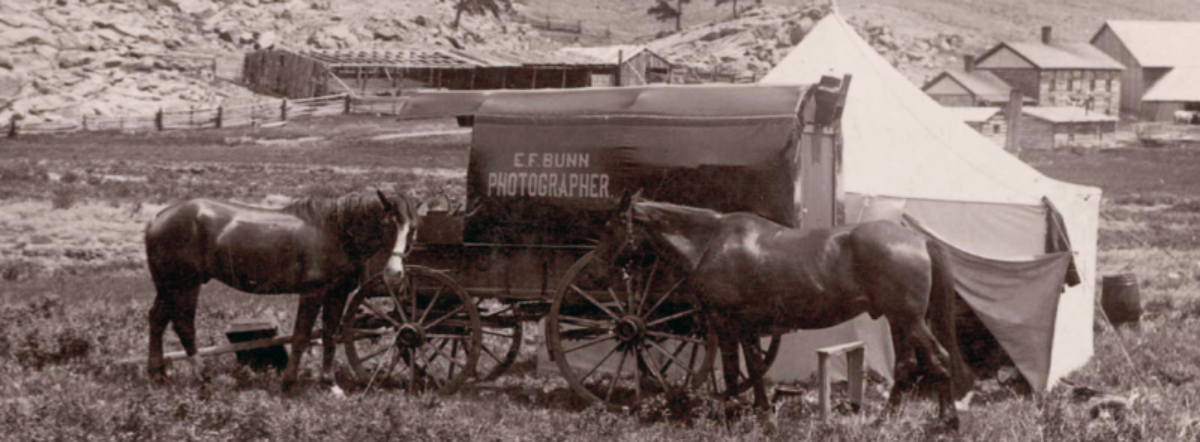One of my goals is to visit Colorado’s small libraries and museums to learn from their collections. In August I visited the northeastern corner of Colorado, a sparsely populated area comprised of farming and ranching communities, about 175 miles northeast of Denver.

My first stop was the Heginbotham Library in Holyoke. A former private home, now the local public library, has a small collection of local history books and a few photographs of the area.
My next stop was the Phillips County Museum in Holyoke, which holds a treasure trove of items related to local history, including items collected by local families–clothing, memorabilia, tableware and photographs. I found some surprisingly artistic photographs in their collection.
This post examines William Carder (W. C.) Powers, a photographer active in Holyoke for about 10 years between 1889 and 1899. Powers was born in Eddyville, Iowa in 1859 to William Carder Powers and Emily Jane (Blair) Powers. He worked as a machinist in Iowa before moving to York, Nebraska. He arrived in Holyoke in 1889, less than a year after the town was incorporated.

Powers plied his trade out of a photo car opposite the State Herald newspaper office, advertising his ability to make images of farms and dwellings. He touted his ability to process the photos in his own studio, rather than send them out of town to be finished. On March 8, 1889, The Herald announced that Powers was photographing prominent buildings in Holyoke for use by the board of trade. His photographs may have been used in a small booklet entitled, Holyoke and Phillips County. 1890 : The Metropolis of Northeastern Colorado. The Garden Spot of the Rain Belt Country … held by the American Antiquarian Society in Worcester, Massachusetts. Powers sold individual photographs of the buildings for twenty-five cents.

In July 1889, Powers was awarded half interest in a patent for a camera attachment with Orlo L. Munger of Gresham, Nebraska.
Powers traveled between Colorado and Nebraska for his photographic work throughout the 1890s, setting up temporary workrooms in Venango, Grant and Wallace, Nebraska. By 1891, he also worked as a plumber in Holyoke and Grant. During the winter months, he repaired frozen water pipes and in the warmer weather he fixed water hydrants, improved hotel plumbing and sold lawn sprinklers and hose. By 1893, Powers was appointed Superintendent of the Water Works in Holyoke.
Although he lived in a rural area, Powers made sophisticated photographs. He captured the flooded streets of Holyoke after a big rain storm in June 1895, showing Dr. F. M. Smith, C. J. Slater and G. W. Shuler rowing a boat along the aptly named Inter Ocean Ave. He made two photographs, one horizontal, one vertical, of members of the Happy Hour Club showing the six women playing a table game. The women are standing in front of an elaborate painted backdrop.
Powers also photographed a posed medical scene, with a man uncomfortably lying on a table with two men administrating aid. The photographer used a reflecting screen, seen to the left of the patient’s feet, to boost the natural light coming into the studio. Also, notice the use of the same backdrop as seen in the Happy Hour group.

In 1899, Powers moved his family to Holdrege, Nebraska, 170 miles from Holyoke, where he opened a second studio. A year later he sold his Holyoke studio to Nicholas A. Linstrom from Edgar, Nebraska, although there is no proof Linstrom actually ever did open for business in that location. In 1901 Powers sold his Holdrege gallery and moved to Salt Lake City, before relocating permanently to Los Angeles. He opened a studio with H. A. Konold at 453-1/2 South Spring street. They specialized in developing for and printing photographs for amateurs and making lantern slides and souvenir postal cards. By 1910, Powers ran his own studio until his death on July 30, 1913.
My thanks to Carol Haynes and Hilda Hassler for their assistance in accessing the Phillips County Museum’s photo collections, Gretta Cox-Gorton, Library Assistant, American Antiquarian Society, Beverly Brannan, former Curator of Photography, Congress, and Karen Hendrix for her photographic expertise. This research trip was possible due to the generosity of the The Peter E. Palmquist Memorial Fund for Historical Photographic Research.
